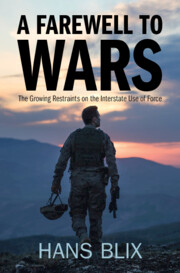Book contents
- A Farewell to Wars
- A Farewell to Wars
- Copyright page
- Contents
- Foreword
- Abbreviations
- 1 Introduction
- 2 Interstate Uses of Force, Tensions and Restraints by Regions since World War II
- 3 Interstate Uses of Force, Tensions and Restraints during Major Phases of International Relations since World War II
- 4 Incentives to the Interstate Uses of Force and Restraints
- 5 Historical Evolution of Norms and Other Means to Restrain the Use of Force
- 6 Overview of Disincentives to and Restraints on the Interstate Use of Force
- 7 Military Strength to Deter Others from Using Force
- 8 Nuclear and Other Non-conventional Weapons and Means as Deterrents and Threats
- 9 Disarmament as Restraint on the Use of Force
- 10 Preventing the Interstate Use of Force by Preventing or Solving Conflicts
- 11 Restraints on the Interstate Use of Force through Legal Norms
- 12 UN Charter Articles Relating to the Use of Force
- 13 The Security Council May Use or Authorize States or Regional Organizations to Use Force
- 14 The Right to Individual and Collective Self-Defence as an Exception to Art. 2:4
- 15 Interventions Triggered by Factors Unforeseen at the Adoption of the Charter’s Ban on the Interstate Use of Force
- 16 Interventions Seeking Regime Change, Protection of People or Punishment
- 17 Findings Regarding the Role of Norms to Restrain the Interstate Use of Force
- 18 States are Saying Farewell to Wars
- Bibliography
- Index
16 - Interventions Seeking Regime Change, Protection of People or Punishment
Published online by Cambridge University Press: 09 November 2023
- A Farewell to Wars
- A Farewell to Wars
- Copyright page
- Contents
- Foreword
- Abbreviations
- 1 Introduction
- 2 Interstate Uses of Force, Tensions and Restraints by Regions since World War II
- 3 Interstate Uses of Force, Tensions and Restraints during Major Phases of International Relations since World War II
- 4 Incentives to the Interstate Uses of Force and Restraints
- 5 Historical Evolution of Norms and Other Means to Restrain the Use of Force
- 6 Overview of Disincentives to and Restraints on the Interstate Use of Force
- 7 Military Strength to Deter Others from Using Force
- 8 Nuclear and Other Non-conventional Weapons and Means as Deterrents and Threats
- 9 Disarmament as Restraint on the Use of Force
- 10 Preventing the Interstate Use of Force by Preventing or Solving Conflicts
- 11 Restraints on the Interstate Use of Force through Legal Norms
- 12 UN Charter Articles Relating to the Use of Force
- 13 The Security Council May Use or Authorize States or Regional Organizations to Use Force
- 14 The Right to Individual and Collective Self-Defence as an Exception to Art. 2:4
- 15 Interventions Triggered by Factors Unforeseen at the Adoption of the Charter’s Ban on the Interstate Use of Force
- 16 Interventions Seeking Regime Change, Protection of People or Punishment
- 17 Findings Regarding the Role of Norms to Restrain the Interstate Use of Force
- 18 States are Saying Farewell to Wars
- Bibliography
- Index
Summary
Many interventions have been undertaken since WWII for familiar reasons such as regime change. They have almost invariably been judged as breaches of the UN Charter prohibition of the interstate use of force and the claimed justifications of self-defence and protection of nationals have been rejected. Examples are the cases of the US interventions in the Dominican Republic (1965), Grenada and Panama (1989) and the Russian interventions in Georgia (2008) and Ukraine (2014 and 2022-). Even Viet Nam’s intervention in Kampuchea (1978) removing the blood-stained Pol Pot regime was judged critically by the UN General Assembly. In 1999, Prime Minister Tony Blair said in a speech that even though the principle of non-interference should not be jettisoned too readily, he queried whether it should not be qualified through ‘a new framework’ to permit action to remove ‘evil’ dictators like Saddam Hussein or Slobodan Milosevic. However, the massive bombings of Kosovo in 1999 undertaken without Security Council approval and claimed to have been for humanitarian reasons have remained controversial and have not been seen as a legal precedent.
Keywords
- Type
- Chapter
- Information
- A Farewell to WarsThe Growing Restraints on the Interstate Use of Force, pp. 240 - 255Publisher: Cambridge University PressPrint publication year: 2023



